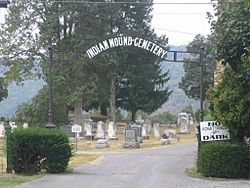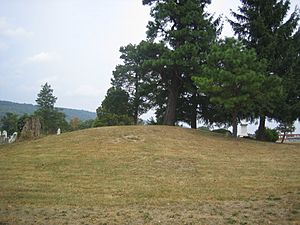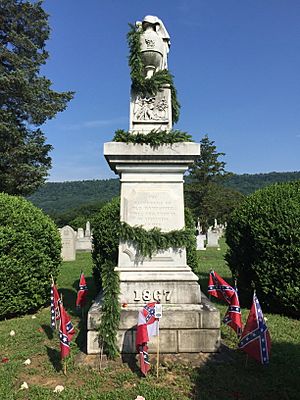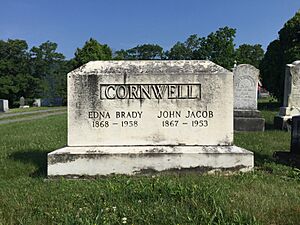Indian Mound Cemetery facts for kids
Indian Mound Cemetery is a special cemetery in Romney, West Virginia. It sits on a high point overlooking the South Branch Potomac River and Mill Creek Mountain. The cemetery is famous because it has an ancient Romney Indian Mound at its center. This mound was built by the Hopewell people long ago.
The cemetery is also home to Fort Pearsall, the Confederate Memorial, and the Parsons Bell Tower. Many people who were first buried in Romney's Old Presbyterian Cemetery were later moved here. The Indian Mound Cemetery Association, Inc. takes care of the cemetery today.
Many important people are buried here. These include two governors of West Virginia, a U.S. House Representative, and a United States Secretary of the Army. An owner of the Washington Football Team is also buried here. You can also find descendants of George Washington's family.
A few years ago, the Confederate Monument was marked with spray paint. This happened just before its 150th anniversary. The damage to the monument has since been fixed.
History of Indian Mound Cemetery
The Ancient Romney Indian Mound
What the Mound Looks Like
The Romney Indian Mound is a burial mound. It is about 7 feet (2.1 meters) tall and 15 feet (4.6 meters) wide. Experts believe it has been opened before. This mound is the biggest of its kind left in the Eastern Panhandle of West Virginia.
It is like many other small burial mounds found across eastern North America. These mounds were built during the Middle and Late Woodland periods (around 1 to 1000 CE). The Romney Indian Mound has always had pine trees growing on it. Some of these trees are still there today.
How the Mound Started
The Romney Indian Mound was built where two old trails met. One was the Shawnee Trail, which went north and south. The other was the Indian Road, which went east and west. This Indian Road later became the Northwestern Turnpike and U.S. Route 50.
The first owner of the land, David Gibson, gave the mound site to Romney. He asked that the mound never be disturbed. Because of this, the city has never dug into the mound. The Smithsonian Institution thinks the mound was built between 500 and 1000 CE. This is based on other similar mounds they have studied. The Hopewell people likely built it. They lived in West Virginia between 500 BC and 1000 CE.
The Romney Indian Mound is special because it is one of the only preserved mounds east of the Allegheny Mountains. It was saved because it sits high above the river. It was also never plowed over by farmers.
Managing the Cemetery: Past and Present
Before the American Civil War, Romney's old cemetery was full. The city needed a new, larger place for burials.
The Indian Mound Cemetery was officially started around 1859. David Gibson gave the land for the cemetery in 1860. This land was part of his nearby farm, Sycamore Dale. The cemetery was first planned with two areas. The higher area around the mound was for general burials. A lower area was set aside for African Americans. This lower area later became the Mount Pisgah Benevolence Cemetery. The Mount Pisgah United Methodist Church now takes care of it.
In 1869, a group met to choose a board of directors for the cemetery company. This company ran the cemetery until 1925. Then, the Indian Mound Cemetery Association, Inc. took over. A board of directors has managed the cemetery since then. In 1925, the association also bought five more acres of land to the north.
The American Civil War and the Cemetery
Battle of Romney Lookout Point
Indian Mound Cemetery was an important spot during the American Civil War. It was on a high bluff. From here, soldiers could see the South Branch Potomac River, the Romney Covered Bridge, and the Northwestern Turnpike. This made it a great lookout point.
In October 1861, Union Army General Scott ordered an attack on Romney. Confederate States Army soldiers prepared for the fight. They placed cannons in Indian Mound Cemetery. They aimed to fire at the Union soldiers as they came through Mechanicsburg Gap. A big cannon battle took place between the Union and Confederate forces. It lasted for about an hour.
Burials During the War
During the Civil War, both Union and Confederate armies used Indian Mound Cemetery for burials. Many soldiers who died near Romney were buried here. Most were wrapped in blankets, and many names are unknown.
Captain Richard Ashby, a Confederate officer, was buried here in 1861. He died from wounds received in a fight. His brother, General Turner Ashby, attended the funeral. Captain Ashby's body was later moved to Stonewall Cemetery in Winchester, Virginia. He was reburied next to his brother. Their grave is marked "The Brothers Ashby."
Confederate Memorial
The Confederate Memorial was put up by local women. It honors the Confederate soldiers from Hampshire County who died in the war. It was dedicated in Indian Mound Cemetery on September 26, 1867. This memorial is thought to be one of the very first permanent memorials to Confederate soldiers in the United States.
Important People Buried Here
Many notable people are buried at Indian Mound Cemetery:
- Stephen Ailes (1912–2001), who was the United States Secretary of the Army.
- William Armstrong (1782–1865), a U.S. House Representative from Virginia.
- John Rinehart Blue (1905–1965), a West Virginia House Delegate from Hampshire County.
- William C. Clayton (1831–1915), a West Virginia State Senator.
- Edna Brady Cornwell (1868–1958), the First Lady of West Virginia.
- John Jacob Cornwell (1867–1953), the 15th Governor of West Virginia.
- Marshall S. Cornwell (1871–1898), a newspaper editor, publisher, poet, and author.
- William B. Cornwell (1864–1926), a railroad and timber business leader.
- John Collins Covell (1823–1887), the Principal of the West Virginia Schools for the Deaf and Blind.
- Dr. William Henry Foote (1794–1869), a Presbyterian clergyman and historian.
- Henry Bell Gilkeson (1850–1921), a West Virginia State Senator and school leader.
- John Jeremiah Jacob (1757–1839), the first Methodist minister in Hampshire County.
- John Jeremiah Jacob (1829–1893), the 4th Governor of West Virginia.
- Howard Hille Johnson (1846–1913), a founder and educator at the West Virginia Schools for the Deaf and Blind.
- James Sloan Kuykendall (1878–1928), a West Virginia House Delegate.
- George Preston Marshall (1896–1969), the owner and president of the Washington Football Team.
- Gilbert Proctor Miller (1866–1927), who started Hampshire County's fruit industry.
- Alexander W. Monroe (1817–1905), a Speaker of the West Virginia House of Delegates and Confederate officer.
- George William Washington (1809–1876), a farmer and diarist.
- Christian Streit White (1839–1917), the Clerk of Court for Hampshire County.
- John Baker White (1868–1944), a military officer.
- Robert White (1876–1935), a lawyer and West Virginia State Senator.
- Joshua Soule Zimmerman (1874–1962), a West Virginia House Delegate and fruit farmer.
Image gallery
See also






















